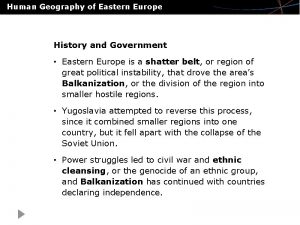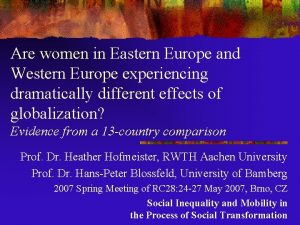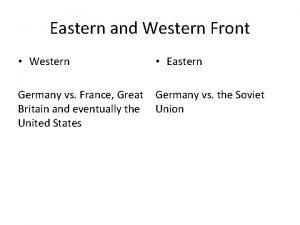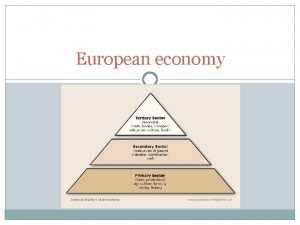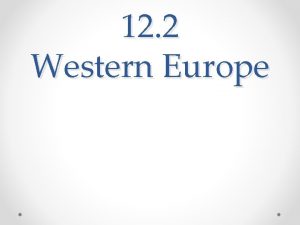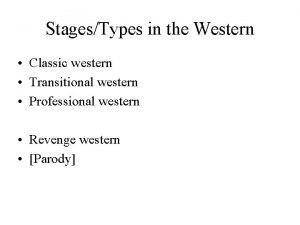Are women in Eastern Europe and Western Europe

























- Slides: 25

Are women in Eastern Europe and Western Europe experiencing dramatically different effects of globalization? Evidence from a 13 -country comparison Prof. Dr. Heather Hofmeister, RWTH Aachen University Prof. Dr. Hans-Peter Blossfeld, University of Bamberg 2007 Spring Meeting of RC 28: 24 -27 May 2007, Brno, CZ Social Inequality and Mobility in the Process of Social Transformation

Presentation Format n n 2 What do we mean by globalization? How is globalization affecting individuals across the life course in Europe? Youth, women, and older workers n How do nation-specific contexts influence the effects? In particular, patterns in Eastern versus Western Europe n How does globalization influence social inequalities for each group? 9/11/2021 Heather Hofmeister

1999 -2005 n n n n 3 Leader: Prof. Dr. Hans-Peter Blossfeld Deputy Director, 2003 -‘ 05: Heather Hofmeister Scientists: 64, from 16 OECD countries plus Estonia Funding: Volkswagen Stiftung, € 1, 4 Million Data: collected from individuals over time Methods: longitudinal event history Foci: n Life course transitions within employment (and family) for youth, women, and older workers n The effects of recent globalization on individuals 9/11/2021 Heather Hofmeister

What do we mean by globalization?

One recent measure of globalization n n 5 KOF Index of globalization (ETH Zurich, Dreher), measuring the degree of globalization in 123 countries Measures: n 34% is economic: flows and restrictions of goods, capital, foreign investment n 37% is social: personal contact (phone, travel), information flows (radio, TV, internet), cultural mainstreaming (Mc. Donalds) n 28% is political: embassies, U. N. involvement, international memberships 9/11/2021 Heather Hofmeister

Graph of individual countries 6 9/11/2021 Heather Hofmeister

Figure of globalization IC Technologies expand networks and exchange of knowledge Faster market transactions GLOBALIZATION Higher levels of cross-border exchange: goods, services, people Deregulation and privatization of industries creates more competition Increasing rates of innovation and economic and social change Any one market‘s fluctuations affect other markets Increasingly volatile and unpredictable markets Increasing uncertainty for employers Employers compete by increasing their “flexibility” 7 Heather Hofmeister

Increasing uncertainty for employers Employers compete by increasing their “flexibility” Figure of globalization 2 Institutionally filtered 8 Employment systems Education systems Family systems Welfare regimes How are job security, flexibility, and work benefits organized How is the transition from education to work organized; what retraining chances exist How are families organized, who has caregiving and earnings responsibilities What domain – state, market, family – should protect people from risk (insurance, care, retirement) Increasing uncertainty for exposed individuals 16. 11. 2006 Dr. Heather Hofmeister

Welfare Regimes: bundles of policies Social-democratic Security from the state EST S DK USA Liberal Security from the market GB NL Conservative Security from a mix MEX 9 Family-oriented Security from families 16. 11. 2006 E PL D-W CZ H I Postsocialist Shared historical context Dr. Heather Hofmeister

Female labor force participation as a percent of all women of working age (15 -64), 1970 -2000 Source: Hofäcker (2006) using OECD Historical Data 2001 10 26 May 2007 Heather Hofmeister

Women’s labor market disadvantage Women are often caregivers for their families and children Women often are hired last, fired first, paid and promoted less, and shifted to lowerprestige jobs 11 26 May 2007 Employers often witness or assume (statistical discrimination) less commitment or experience from women workers or job candidates Dr. Heather Hofmeister

Women‘s vulnerability for flexible work What women want from flexible work “Personal Flexibility” (persönliche Flexibilität) Secure work organized in a time-flexible way 12 Whom employers want to hire for flexible work Flexible Work 26 May 2007 “Personnel Flexibility” (Personalflexibilität) Available, willing, capable worker who can be hired and released as needed at the lowest possible wages. Dr. Heather Hofmeister

How are women‘s careers unfolding compared to n n n earlier generations or cohorts of women? women in other countries? men at the same time in the same country? (Grunow 2006, Blossfeld et al 2006) 13 26 May 2007 Dr. Heather Hofmeister

Research questions 1. Where and why are women increasing or decreasing their overall attachment to the labor market? 2. Where and why do women experience better- or worse-quality job chances? 3. Which characteristics make women especially protected or vulnerable? (Such as education, experience, family status? ) 14 26 May 2007 Dr. Heather Hofmeister

Analysis: Case studies of 13 countries Event-history models of employment transitions using longitudinal data. Cohort comparisons across models of transitions. EST S DK USA GB NL PL D-W CZ H I MEX E 15 16. 11. 2006 Dr. Heather Hofmeister

1. Measuring labor market attachment n n n Staying in a job Looking for a job Returning to a job New job Job Unemployment Reentry job Caregiving, not employed 16 26 May 2007 Dr. Heather Hofmeister

1. Results for labor market attachment State support to stay in (S, NL) State support to exit (DK) High unemployment (PL, H) Declining male wages (US, GB) Flexible work in Maquiladoras (MEX) n n n 17 Rising attachment: 7 countries Declining attachment: 4 countries No change over time: 2 countries Educational and service sector expansion (E, D, I) Dr. Heather Hofmeister

2. Measuring employment quality change n n Change in job prestige Change between employment and unemployment New job type higher prestige same level lower prestige Job Unemployment Caregiving, not employed 18 26 May 2007 Reentry job type higher prestige same level lower prestige Dr. Heather Hofmeister

2. Quality of employment is declining State support to keep jobs secure (S, NL, DK) n n n 19 Declining quality, rising uncertainty: 10 countries Stability in job careers: 3 countries Rising quality, declining uncertainty: 0 countries Dr. Heather Hofmeister

Summary 1. Women in Europe (and North America) are overall increasingly likely to work for pay, with some exceptions based on institutional settings. 2. Women‘s job quality/stability is declining or staying stable, meaning more movement to lower-quality jobs, to unemployment, and longer job search time. 3. Women‘s own characteristics influence their risks. Especially protected Especially vulnerable highly educated low-educated more experienced workers frequent exiters full-time workers part-time workers 20 26 May 2007 Heather Hofmeister

Commonalities among women under globalization n n The quality of women‘s employment is declining or staying stable. Uncertainty is rising. Disadvantages for mid-life women are similar to youth: n n n Coping strategies n 21 More precarious and lower quality jobs More part-time work More jobs with lower occupational standing/income More and longer unemployment More downward mobility Fewer and shorter exits at birth of child 9/11/2021 Heather Hofmeister

What is different between Eastern and Western Europe n Poland Hungary are exceptional in their declines in women‘s labor market attachment through the 1990 s. n n Denmark is also exceptional in its declines in women‘s labor market attachment. n n n 22 Discouraging job market situation + alternative role possible Alternative policy for exiting instead of unemployment Some Western European countries offer more stateorganized job protection that protects women‘s career stability -- Sweden, Denmark, and the Netherlands. Something we call the transition shock. 9/11/2021 Heather Hofmeister

Percent of women who agree with the statement: „A man‘s role is to earn money, a woman‘s role is to look after the house and children“ (in % of birth cohort agreeing, 3 time points) Sources: ISSP, Lück 2006 23 9/11/2021 Heather Hofmeister

Increasing uncertainty for employers Employers compete by increasing their “flexibility” Figure of globalization 2 Institutionally filtered Increasing uncertainty for minorities. . . youth. . . low-educated women. . . low-educated men and higher-educated women. . . higher-educated men 24 16. 11. 2006 Dr. Heather Hofmeister

Conclusions 1. 2. 3. 4. 25 Globalization increases uncertainty in most life course phases related to the labor market in most European countries. Individual resources become increasingly important (e. g. , education, experience, ascribed characteristics). No strong line separates the effects of globalization on Eastern versus Western Europe. Changes in domestic institutions (such as, but not limited to, economic transformations) can create newly vulnerable populations, particularly outsiders: often, but not limited to, youth and mid-life women. 9/11/2021 Heather Hofmeister
 Differences between eastern and western absolutism
Differences between eastern and western absolutism Insidan region jh
Insidan region jh Eastern and western roman empire map
Eastern and western roman empire map Eastern and western hemisphere
Eastern and western hemisphere Which experience led to a deep change in ashoka’s values
Which experience led to a deep change in ashoka’s values Secneer
Secneer Western values vs eastern values
Western values vs eastern values Lesson quiz 13-1 eastern europe
Lesson quiz 13-1 eastern europe Ussr control over eastern europe igcse
Ussr control over eastern europe igcse What is considered eastern europe
What is considered eastern europe Eastern european cuisine
Eastern european cuisine Landforms in southern europe
Landforms in southern europe Shatter belt definition ap human geography
Shatter belt definition ap human geography Offshoring eastern europe
Offshoring eastern europe How did its rivers affect eastern europe
How did its rivers affect eastern europe Europe western uplands
Europe western uplands Western europe after the fall of rome
Western europe after the fall of rome Chapter 14 the formation of western europe
Chapter 14 the formation of western europe Chapter 14 the formation of western europe
Chapter 14 the formation of western europe Total population of europe
Total population of europe Invaders attack western europe
Invaders attack western europe How did germanic tribes divide western europe
How did germanic tribes divide western europe The development of feudalism in western europe
The development of feudalism in western europe Western europe hdi
Western europe hdi Southern and eastern asia map
Southern and eastern asia map Se asia's geography cloze notes 1
Se asia's geography cloze notes 1












